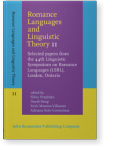Chapter 12
The processing of intrasentential anaphoric subject pronouns in L2 Spanish
This paper examines whether L2 learners of Spanish can attain native-like interpretive and parsing patterns in intrasentential subject anaphor resolution, and the extent to which these patterns are modulated by L1 transfer. Adult advanced L2 learners of Spanish with different L1s (Moroccan Arabic, a null-subject language, and English, a non-null subject language) completed an experiment utilizing online (the moving window paradigm) and offline (answers to comprehension questions) techniques. Both Arabic and English learners of Spanish performed in a native-like way at the interpretive and parsing levels. These patterns suggest that L1 transfer plays no crucial role when interpreting and processing intrasentential anaphoric subjects at least at the advanced level.
Article outline
- 1.Introduction
- 2.Morphosyntactic and anaphoric properties of null and overt subject pronouns in null-subject languages
- 3.Adult L2 acquisition of pragmatic and semantic properties of subject pronouns in null-subject languages
- 4.Research questions and hypotheses
- 5.Experiment
- 5.1Participants
- 5.2Materials and procedure
- 5.2.1Language background questionnaire
- 5.2.2Spanish proficiency test (learners only)
- 5.2.3Working memory test
- 5.2.4Self-paced reading task
- 5.2.5Vocabulary test (learners only)
- 5.2.6Grammar test (learners only)
- 5.3Scoring
- 6.Results
- 6.1RTs at the V
- 6.2RTs at the object NP
- 6.3RTs at the PP
- 6.4Accuracy – subject bias
- 6.5Accuracy – sentence interpretation
- 7.Discussion
- 8.Conclusions
-
Acknowledgements
-
References
